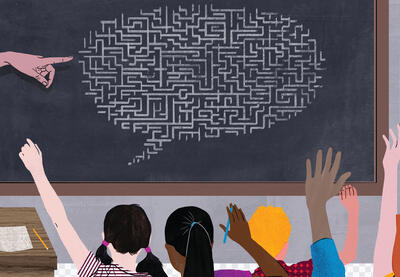I ask a lot of open-ended questions in my history classes, the kinds of questions to which there are no right answers, only good answers (logical, well-supported and so on). A few years ago I started asking myself such a question:
“Am I damaging my students?”
Here’s the context. In the past I hesitated to share my own opinions about the questions we addressed in class (despite the fact that my seventh- and eighth-grade students were keenly interested in knowing where I stood). My hesitation came from a desire to maintain some level of objectivity and my understanding that this is what was expected of me as a teacher. But my attempt to strike a neutral pose began to feel like a major ethical and philosophical quandary: Was it ever possible to disentangle my own biased assumptions from my teaching? Is neutrality possible or even desirable?
Students look to their teachers to be the authority on the course material. And even though we may be aware that we are making choices about what content we include and exclude and whose perspectives we endorse and whose we disregard, most of us still like to pretend we are maintaining some level of objectivity. I came to the conclusion that objectivity is practically impossible. What’s more, it can hinder our students’ moral development. And cultivating morality is uniquely essential to the project of teaching history. Studying the past offers a venue for reflecting on the human condition and developing a sense of right and wrong. We study who we were so that we can figure out who we want to be.
“That’s Your Opinion”
Justin P. McBrayer, an assistant professor of philosophy at Fort Lewis College in Durango, Colorado, posted a thought-provoking op-ed on The New York Times’ “Opinionator” blog in which he argued that today’s students “view moral claims as mere opinions that are not true or are true only relative to a culture.” In other words, he believes that today’s students have an overdeveloped sense of relativism. In his view, young people are taught to distinguish between fact and opinion and thus accept as “fact” only that which can be objectively proven. All opinions or perspectives are, then, considered equal. I see similar struggles in my own students who want to tolerate all views while dismissing none.
This analysis has great relevance to me as a history teacher; I often struggle with how to balance moral relativism and absolutism in our class activities—both among my students and with regard to my own contributions. A student once gave me a note on the last day of school that read, much to my alarm, “Thank you for a great course. I learned that if you look at perspectives that are different, then you will see that everyone is right for different reasons.” I was dismayed because, of course, everyone is decidedly not right for different reasons. Some people are quite wrong about a lot of things, and many of those people feature heavily in the U.S. and global history classes I teach. After receiving this note, I knew I needed to think more carefully about how I was framing issues of neutrality and relativism in my classes.
Don’t Stop at “Multiple Perspectives”
Teachers often diversify and complicate their students’ thinking by talking about studying history from “multiple perspectives.” This approach can be an effective way to broaden students’ thinking and include voices from outside of the dominant narrative.
I have come to see, however, that the inclusion of “multiple perspectives” without sufficient attention to power, intent and privilege makes it challenging for history teachers to honor their moral imperative. History is not just a collection of different perspectives or stories; it is a collection of arguments historians have had about how best to tell these stories. I often differentiate between “history” and “what happened in the past” to get at this important distinction. If we only talk about “multiple perspectives” and locate the various stories of the past on a “continuum of perspective”—without assigning any normative judgments to them—we forestall attempts at determining historical responsibility and causation. We remove the moral judgment implicit in the scholarly study of history.
What's worse for students: the acknowledgment of subjectivity or the pretense of objectivity?
Talking about perspectives without talking about power can imply an equivalency of viewpoints that brings with it a very real danger of erasing historical injustice. Do we consider the perspective of the slave owner and the enslaved person to be equally valid? There is room to examine both and good historical justification for doing so, but just using “perspective” feels too neutral and too blasé about the role power and injustice played in shaping events in the past and the history that emerged out of them.
Instead of multiple perspectives, I suggest the term “narrative,” which we can define as “perspective + power.” Using a narrative means interrogating the story and the storyteller, shifting perspective but also opening us up to questions of authority, power and control, sometimes referred to as critical literacy. Narrative offers us a way to frame history as multiple stories about the past that exist in tension with one another while also allowing us to talk about right and wrong. Without it, we risk producing relativists who tolerate all views and critique and interrogate none.
Acknowledge Your Power as the Teacher
As the designer of my students’ experience, I wield tremendous power to control the narrative and flow of information. I choose the texts, I ask the questions and, ultimately, I assess my students’ knowledge and learning. My neutrality is already called into question by virtue of the materials we use. There is an urgent need for teachers to be aware of our own assumptions and biases, but I think it’s impossible to separate them completely from our teaching. If part of the lesson is that perspective and power influence the telling of history’s stories (i.e., there’s no such thing as objectivity), how can we cast ourselves as neutral authorities? What’s worse for students: the acknowledgment of subjectivity or the pretense of objectivity?
Know and Teach About Your Biases
During a unit on the Industrial Revolution, one student asked why we kept reading sources about women’s experiences. A student warmed my heart by saying, “Jon’s a feminist and he wants us to think about women’s roles in the past.” I didn’t shy away from that label; rather, I embraced it and was glad my students had noticed.
I acknowledge the fact that I want students to think how I do, as an expert in historical thinking. I also want them to learn how to build reasoned and well-articulated arguments. (Of course, I consider my own views to fall into that category!) So, I think it’s okay to recognize and teach from one’s own bias and preconceptions provided that a) there is room for dissension and debate and b) students are assessed on the clarity of their thinking, soundness of their arguments and judiciousness of their evidence—and not their parroting of my ideas.
One of my favorite lessons is to compare different textbooks’ versions of the same event. This approach means studying historiography, in which—in the words of Michael Conway, writing for The Atlantic—“the barrier between historian and student is dropped, exposing a conflict-ridden landscape.” Since I am effectively the historiographic designer of my history curriculum, my own bias can become a part of the lesson. The key is to own and acknowledge my bias as I assess and evaluate effective historical thinking.
Recognize Your “Red Lines”
As students improve their discussion and argumentation skills, they will inevitably challenge each other. At other times, students will introduce ideas and ways of thinking that do not mesh with our subjective interpretations of the issue. Preparing for these moments means knowing what types of comments we as teachers will let slide and what we will flag as unacceptable. This means thoroughly assessing our own “red lines,” those areas that we will not permit students to enter. For example, I might encourage a debate about whether women’s lives were improved during the Industrial Revolution or whether it opened new opportunities for exploitation and marginalization, since both of these arguments could be consistent with a feminist perspective, but I wouldn’t allow students to assert that women should have remained outside the paid workforce. When my class compares the antebellum development of the North and South, I always intervene if a student concludes that the South “needed” slaves to work plantations; instead, we connect racist ideology to the motive to maximize profits.
Empower Students and Encourage Them to Use Their Power
While I encourage my colleagues to own their subjectivity (to an extent), I’m still not advocating for proselytizing. My teaching needs to focus on rigorous historical thinking—and not convincing students to adopt my ideas. In other words, my goal is for my students to learn to think how I think but not necessarily what I think. Inevitably, they may reach conclusions similar to my own, but the process of developing historical thinking skills is more important than whether or not they agree with me.
I try to remain in the center of a spectrum with evangelizing on one end and bending over backwards to accommodate all points of view on the other. It is my hope that—through this approach—I can increasingly rely on students to handle the dissension, interrogation and rigorous analysis necessary for good historical work and effective moral development. If the students are monitoring one another, calling each other out and pushing on each other’s assumptions, then my role is more referee than sage. And in that role, I can help maintain a culture of safety (to the extent that safety is possible) and empowerment.
Howard Zinn cautions that, in studying history, “it is impossible to be neutral … neutrality means accepting the way things are now.” My ambition is for students in my class to want to make change and to develop strong moral views—which means we teachers can’t pretend that we don’t have them. By owning our morality and demanding rigor in our classrooms, we can knowingly, mindfully and progressively develop students’ abilities to articulate and assess the human experience.



